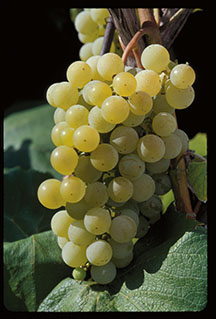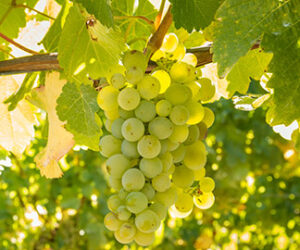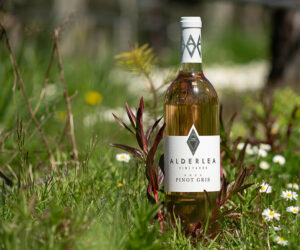
Edelweiss is best known as the European mountain flower with a pleasing floral scent. The 1959 Rogers and Hammerstein musical, “The Sound of Music,” immortalized the Edelweiss flower as Captain Georg Ritter von Trapp sang of its hardiness to bloom, die and bloom again. It is the flower of kings and emperors symbolizing strength, love, dedication and bravery. The Edelweiss (pronounced A-del-VISE or A-del-WISE) grape has similar characteristics as it is winter hardy and will bloom early and will produce abundantly for many years. As delicate as a flower, Edelweiss wine delivers a delicate floral aroma with mouthwatering sweet peach, pear, honey, and pineapple flavors in the glass.
Edelweiss means noble (edel) white (weiss) in Germany. The Edelweiss grape, however, is a hybrid white grape variety that was produced in 1978 by Elmer Swenson of Osceola, Wisconsin in cooperation with the University of Minnesota. Edelweiss is a hybrid cross of Minnesota 78 (Vitis riparia) and Ontario (Vitis labrusca). It is a seeded table grape but it can produce a remarkable Riesling-like semi-dry, semi-sweet, or sweet white table wine when harvested at 14–16 °Brix. It is necessary to chaptalize at this Brix level to raise the sugar content to 22 °Brix to achieve alcohol content by volume to 11 1⁄2%. If harvested fully mature or late harvested, the native labrusca parentage becomes dominant in the aroma and flavor.
Edelweiss is winter hardy (to -15 °F/-26 °C) but should be mulched for wintering if it is planted in colder climates reaching temperatures as cold as -30 °F (-34 °C). It is fairly resistant to most diseases but is mildly susceptible to powdery mildew. It buds early and matures early, similar to its parent, Ontario. Care may be necessary to prevent frost damage since it does bud early. Caution should be exercised when tying young shoots together as they can easily break. Large loose grape clusters of medium to small gold berries can weigh a pound (454 grams) or more at harvest in late August or early September.
Because Edelweiss is considered a high acid grape at 14–16 °Brix, several measures may be necessary to balance the total acidity when making wine. Yeast selection and potassium bicarbonate (prior to cold stabilization) are the methods used to lower total acidity. Amelioration (4 parts juice to 1 part water with 36 oz./1020 g of sugar) is generally not used as a method of acid reduction unless the grapes are harvested at 22 °Brix, in which case you can consider diluting the juice because there will be a marked increase of labrusca aroma and flavor. The addition of elderflowers (1 oz./28 g per 5 gal./21 L) can be used during primary fermentation if a strong grapey aroma and flavor is detected. The use of dried elderflowers can heighten the floral aroma. Malolactic fermentation is also not used with this white grape since it tends to diminish the fruity aroma and flavor as the malic acid is lowered.
Sweetening with cane sugar will also help to balance the finished wine. Remember to add potassium sorbate to the finished wine (dissolved in warm water) prior to the addition of sugar for sweetening. The amount of residual sugar added will depend on your personal preference as well as the level of acidity. If the total acidity (TA) of the finished wine is above 0.8% TA, begin sugar additions (with a small sample batch) at a level of semi-dry and taste the wine after each addition of sugar is made until you are pleased with the tart/sweet wine balance. Taste the wine again the next day to confirm your preference before the entire batch of Edelweiss is sweetened. Note the viscosity of the wine will increase as the sugar content increases.
Cool fermentation temperatures (68–60 °F/20–15 °C) will help retain the delicate floral and fruity aromas and flavors. To help prevent oxidation of Edelweiss during fermentation, try fermenting the juice in a glass carboy instead of a plastic fermenting bucket. A carboy will minimize the chance of oxidation by limiting the amount of air space. A blow-off assembly is used on the carboy instead of an airlock. It can be easily made using 2 feet (0.6 m) of 1⁄2-in. tubing attached to a short curved stem (similar to a racking tube or cane) that is attached to a rubber bung (stopper). The bung is inserted into the opening of the carboy. The tubing end is inserted into a clean and sanitized gallon jug that is 3⁄4 full of water. The curved stem allows excess carbon dioxide to flow into the water by way of the tubing. The blow-off assembly prevents excessive foaming during fermentation that would clog an air lock if used in this type of closed fermenter. For 5 1⁄2 to 6 gallons (21 to 23 L) of juice, a 6 1⁄2-gallon (25-L) carboy can be used with a blow-off assembly until the fermentation slows down to below 8 °Brix/1.030 SG on the hydrometer. An airlock can be used, if desired, when the fermentation slows down significantly.
Once you have smelled its delicate floral aromas and tasted the flavors, perhaps you too will love Edelweiss wine.
Edelweiss Recipe
Yield 5 gallons / 21 liters
Ingredients
75 pounds (34 kg) Edelweiss grapes or 6 gallons (23 L) fresh juice
pectic enzyme per manufacturer’s directions
yeast (Dry: Lalvin 71B-1122, Lalvin ICV D-47, Gist-brocades Fermiblanc. Liquid: White Labs WLP727 Steinberg-Geisenheim or Wyeast 4783 Rudisheimer)
5 teaspoons complete yeast nutrient bentonite fining per manufacturer’s directions
A total of 13–15 Campden tablets or 13–15 teaspoons sulfite solution*
Optional
Rice hulls during pressing
acid reduction-potassium bicarbonate (use no more than 3 teaspoons per gallon)
if sweetening, finished wine-potassium sorbate
Sulfite test kit — Titrets™
antifoam, if desired
1 oz./28 g dried elderflowers
6 1⁄2-gal./25-L carboy to ferment and 5-gal./19-L carboy to store the wine
*Sulfite is usually added before and after fermentation and in smaller dosages at racking. Typical dosage is 1 Campden tablet per gallon, or, if using the sulfite solution, use 1 teaspoon sulfite solution (liquid) per gallon of “must” (juice) or wine. See recipe for step-by step instructions. WineMaker’s sulfite calculator is available online at http://www.winemaker
mag.com/suflitecalculator/index.htm.
To make a sulfite solution: to 1 cup (8 oz. or 189 mL) of water add 1 oz. (28 g or 4 1⁄2 teaspoons) potassium metabisulfite. Stir to dissolve. Use 1 teaspoon sulfite solution for each gallon (3.8 L) of juice or wine (1 teaspoon sulfite solution per gallon of wine equals approximately 23 parts per million (ppm) free sulfur dioxide). Store the metabisulfite solution in a glass jar with the metal lid lined with plastic wrap to avoid interaction with the metal.) Label the jar “sulfite solution for wine.” Store the solution away from the reach of children.
Step by step
1. Sanitize all equipment before and after each use.
2. If you are working with fresh grapes, remove & discard all spoiled grapes. Stem and crush grapes. Place grapes and juice in a primary fermenter container.
3. Add pectic enzyme according to manufacturer’s directions. Mix thoroughly. Allow pectic enzyme to work several hours or 24 hours before pressing.
4. Press grapes using rice hulls to extract as much juice without applying excessive pressure during the pressing process. If using fresh juice, ask the vendor for the °Brix, total acidity (TA), pH, and SO2 level (sulfur dioxide).
5. Test the juice for °Brix using a hydrometer. Add sugar, if needed, to create a potential alcohol level of 11 1⁄2% by volume/22 °Brix/1.090 Sprecific Gravity. Record the information in your winemaker’s record book.
6. Test the juice for total acidity (TA) using an acid test kit. Record the information in your winemaker’s record book. If the TA is 1.0% or higher, consider using Lalvin 71B-1122 yeast to help reduce the acid level during fermentation. Another TA reading will be done after the first racking to determine if potassium bicarbonate will be used to reduce acidity.
7. Test the juice for pH if you own a pH meter. Record the information in your winemaker’s record book.
8. Test juice for sulfite level using Titrets™ to confirm the SO2 level before adding additional sulfite. Add Campden tablets or sulfite solution to achieve approximately 40 parts per million (ppm) sulfur dioxide. Record the information in your winemaker’s record book.
9. Place juice in a 6.5 gal./24 liter glass carboy. Dissolve the complete yeast nutrient in a cup of juice. Pour nutrient solution into the carboy and stir thoroughly.
10. Hydrate yeast (per manufacturer’s directions) by sprinkling the yeast over 1⁄2 cup (4 ounces/120ml) warm water. Do not exceed 105 °F/40 °C. Let stand 5 to 10 minutes. Stir. Add yeast mixture to juice.
11. Add antifoam, if desired, per manufacturer’s directions.
12. Place blow-off assembly on carboy. Make sure the tubing is submerged in the water of the jug.
13. Ferment at 68–60 °F/20–15 °C, stirring at least twice a day for 3 to 4 days. Take a hydrometer reading.
14. At 0 °Brix to -1.5 °Brix/1.000-0.994 Specific Gravity, sulfite the wine by adding 4 Campden tablets or 5 teaspoons of sulfite solution.
15. Transfer the wine (away from the sediment) into a smaller carboy to minimize air space. There should be no more than two fingers of air space in between the wine level and the rubber stopper.
16. Add bentonite, according to manufacturer’s directions, to clear the wine. Keep the wine in a cool area to hasten clearing of sediment.
17. Rack (transfer the wine away from the sediment) in 3 to 4 weeks. Attach an airlock and stopper onto the carboy.
18. Test the sulfite level using Titret™ and add sulfite, if needed, to maintain 40–50 ppm.
19. Rack the wine a second time in another 4 to 6 weeks.
20. Taste the wine. Test the wine for total acidity using an acid test kit. Record the TA in your winemaker’s record book. Determine if the acidity of the wine should be lowered with potassium bicarbonate to make the wine pleasing to taste (and prevent acid indigestion). Do not exceed 3 teaspoons of potassium bicarbonate per gallon. Record the amount of potassium bicarbonate used and the date in your winemaker’s record book. Place the wine in a cold storage area (33–40 °F/0–4 °C) for 3–4 weeks to cold stabilize. Test for TA using an acid test kit after cold stabilization. Record the TA and the date in your winemaker’s record book.
21. Rack the wine a third time.
22. Determine if you wish to sweeten the wine. Potassium sorbate must be added if the wine will be finished as a sweet wine. Determine the level of sweetness desired and add the dissolved cane sugar to 1 gal./3.79 L of wine. Allow the wine to set for 1⁄2 hour before tasting. It is easier to make further adjustments with 1 gallon of wine than to make 5 gal./19 L of wine too sweet. Once the desired sweetness is reached, multiply the amount of sugar used to sweeten 1 gal./3.79 L by the number of gallons or liters of wine remaining to be sweetened. Record the total amount of sugar added in your winemaker’s record book.
23. Filter the wine to achieve a brilliant clarity.
24. Test the sulfite level using Titret™ and add sulfite, if needed, to maintain 35–45 ppm free sulfur dioxide. If you own a pH meter, follow the free SO2 chart recommendations for wine and add 10% to the number in order to be on the safe side for bottling conditions.
25. Sanitize all bottles and equipment used for bottling. After bottling, allow the bottles to remain upright for 7 to 10 days to allow the cork to seat properly in the bottle. Place bottles on the side to keep the cork moist while the wine is aging. If screw top closures are used, the bottles can remain upright to store the wine. Cheers!







